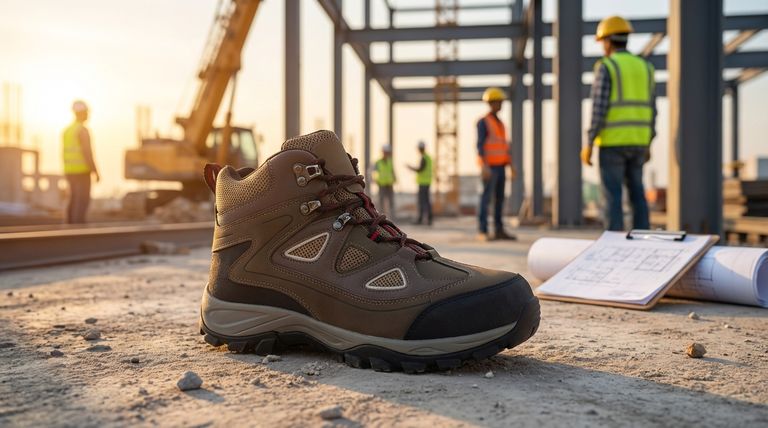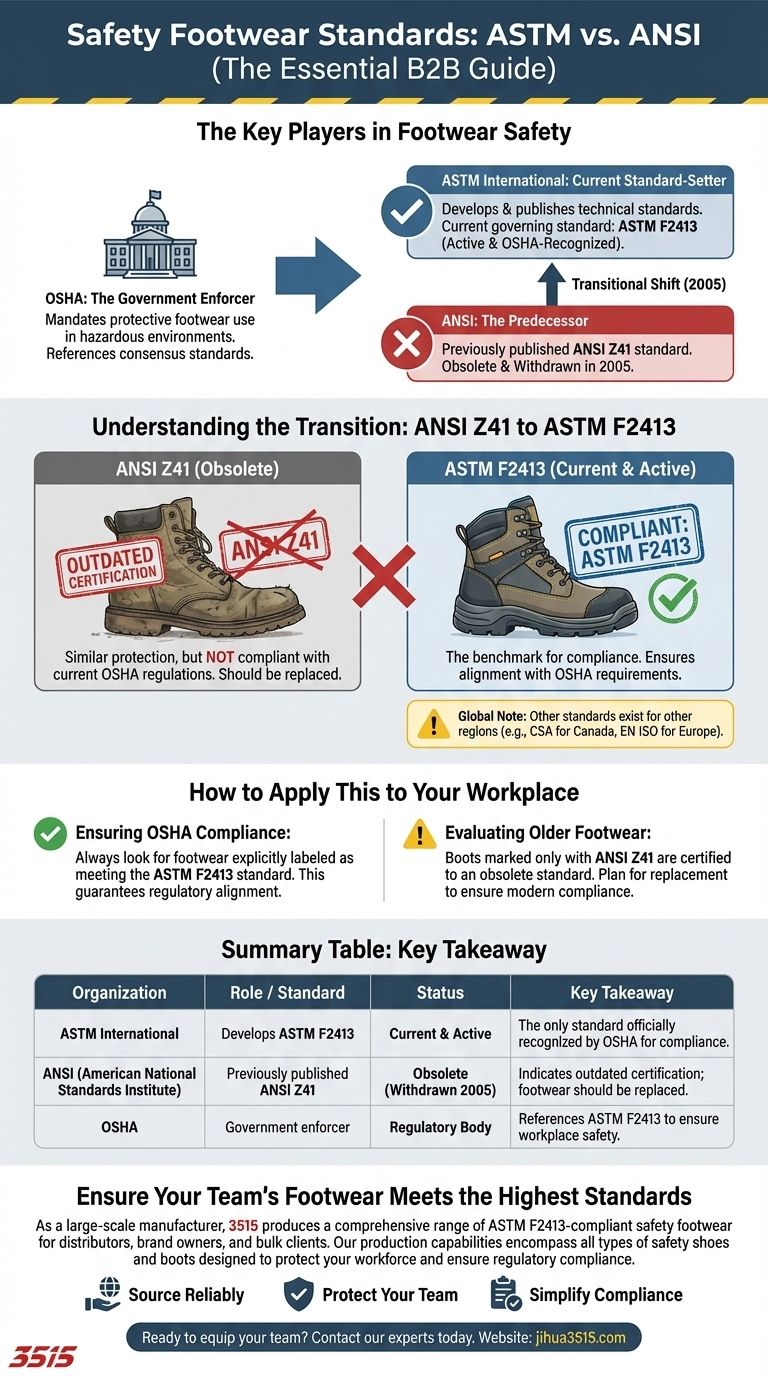The two primary organizations historically involved with setting US safety footwear standards are ASTM International and the American National Standards Institute (ANSI). However, it is critical to understand that the current standard, ASTM F2413, has officially superseded the older ANSI Z41 standard. The U.S. Occupational Safety and Health Administration (OSHA) now references the ASTM standard for compliance.
While both ASTM and ANSI are names you will encounter, the key takeaway is that ASTM International now sets the active standard for safety footwear in the United States. A boot's compliance is determined by its adherence to the current ASTM F2413 specifications, not the obsolete ANSI Z41 standard it replaced.

The Key Players in Footwear Safety
To understand compliance, you must see how the different organizations work together. It's a system of enforcement, development, and accreditation.
OSHA: The Government Enforcer
The Occupational Safety and Health Administration (OSHA) is the US government agency responsible for ensuring safe working conditions.
OSHA does not create its own detailed standards for footwear. Instead, it mandates the use of protective footwear in hazardous environments and references consensus standards developed by other expert organizations.
ASTM International: The Current Standard-Setter
ASTM International, formerly the American Society for Testing and Materials, is the organization that develops and publishes the technical standards.
The current governing standard for protective footwear is ASTM F2413. This document details the minimum requirements for performance, testing, and labeling of safety-toe footwear to protect against a variety of workplace hazards.
ANSI: The Predecessor
The American National Standards Institute (ANSI) previously published the standard for safety footwear, known as ANSI Z41.
This standard was withdrawn and officially replaced by ASTM F2413 in 2005. While the core protection levels are similar, ASTM is the current, active standard recognized by OSHA.
Understanding the Transition from ANSI to ASTM
The shift from ANSI to ASTM is the primary source of confusion in the industry. Understanding this history clarifies which labels matter today.
Why the Change Occurred
The move to ASTM F2413 was part of a broader effort to streamline standards development. ASTM's process was seen as more agile for keeping pace with new materials and technologies in the footwear industry.
The Impact on Labeling
Footwear that conformed to the old ANSI Z41-1999 standard carries similar protection ratings to the current ASTM F2413 standard.
However, for a boot to be considered compliant with current OSHA regulations, it must be certified and labeled as meeting the ASTM F2413 standard. Any reference to ANSI alone signifies an outdated certification.
A Note on Global Standards
While ASTM is the benchmark in the US, other standards exist globally. The CSA Group (Canadian Standards Association) sets standards for Canada, and EN ISO (European Norm International Organization for Standardization) sets them for Europe.
How to Apply This to Your Workplace
Making the right choice is about verifying compliance with the current, correct standard.
- If your primary focus is ensuring OSHA compliance: Always look for footwear explicitly labeled as meeting the ASTM F2413 standard. This is the only way to guarantee you are using equipment that aligns with current regulations.
- If your primary focus is evaluating older or existing footwear: Recognize that any boot marked only with ANSI Z41 is certified to an obsolete standard and should be replaced to ensure modern compliance and protection.
Ultimately, choosing footwear certified under the current ASTM standard is the definitive way to protect your team and meet your safety obligations.
Summary Table:
| Organization | Role / Standard | Status | Key Takeaway |
|---|---|---|---|
| ASTM International | Develops the ASTM F2413 standard. | Current & Active | The only standard officially recognized by OSHA for compliance. |
| ANSI (American National Standards Institute) | Previously published the ANSI Z41 standard. | Obsolete (Withdrawn in 2005) | Indicates outdated certification; footwear should be replaced. |
| OSHA | Government enforcer; mandates use of protective footwear. | Regulatory Body | References ASTM F2413 to ensure workplace safety compliance. |
Ensure Your Team's Footwear Meets the Highest Standards
As a large-scale manufacturer, 3515 produces a comprehensive range of ASTM F2413-compliant safety footwear for distributors, brand owners, and bulk clients. Our production capabilities encompass all types of safety shoes and boots designed to protect your workforce and ensure regulatory compliance.
Partner with us to:
- Source Reliably: Get certified safety footwear that meets current OSHA requirements.
- Protect Your Team: Equip your workforce with footwear tested for impact, compression, and other hazards.
- Simplify Compliance: Eliminate the confusion around standards with products clearly labeled to ASTM F2413.
Ready to equip your team with compliant safety footwear? Contact our experts today to discuss your needs and receive a quote.
Visual Guide

Related Products
- Safety Footwear Wholesale Manufacturer for Custom OEM/ODM Production
- Premium Flame-Retardant Waterproof Safety Boots and Shoes
- Advanced KPU Athletic Safety Shoe with Steel Toe Cap Anti-Slip Rotary Lacing System
- Wholesale Premium Waterproof Nubuck Safety Shoes Boots
- Premium Suede Metatarsal Guard Safety Boots Work Shoes
People Also Ask
- What are OSHA approved shoes? Understanding the Correct Standards for Workplace Safety
- How do safety shoes contribute to cost savings for companies? A Strategic Investment in Risk and Cost Management
- What cultural and environmental considerations are tied to wearing shoes indoors? Balance Hygiene, Tradition, and Foot Health
- What are the differences between steel toe, composite toe, and alloy toe Wellington boots? Choose the Right Safety Toe for Your Job
- How long can you wear safety boots? The Lifespan is Determined by Wear, Not Time



















